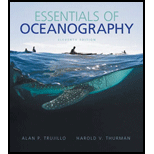
The way in which the view of the ocean by the early Mediterranean cultures influence the naming of the planet Earth.
Answer to Problem 1CC
The people of the early Mediterranean cultures thought that the Earth was composed of more giant landmasses on which they lived on, surrounded by water bodies like the Mediterranean Sea. Besides, ocean exploration was not known to them during that time. Therefore, the planet got its name “Earth” that is different from its actual composition.
Explanation of Solution
The Earth has oceans on its surface covering nearly
There existed numerous cultures in the past that thrived near the Mediterranean Sea which anticipated that the world is made up of huge landmasses that may be enclosed by marginal water bodies. They believed the Earth to be planet that possess more landmasses than oceans. Only because of the fact that people lived on the land surface, the Earth was named so. If the humans were living in the water, the Earth would have been named as relative to water such as “Ocean”, “Aqua”, “Hydro” or “Water”. Moreover, the planet got its name even before the advent of ocean exploration.
Want to see more full solutions like this?
- the questions often be used to determine the age ofmetamorphic rocks.Questions1. List the relative age of the rocks in Figure 2with oldest first.2. What stratigraphic principles did you use todetermine the age of the rocks in Figure 2?3. If layer A is 418 Ma and layer B is 388 Ma, what geological Period(s) are layers C and D likely to befrom?4. Layer C contains fish fossils.a. Circle the rock type for layer C. Igneous Sedimentary Metamorphicb. Explain how the fish fossils could be used to determine the date of rocks elsewhere.c. Outline possible reasons why the other layers do NOT contain fossilarrow_forwardthe questions often be used to determine the age ofmetamorphic rocks.Questions1. List the relative age of the rocks in Figure 2with oldest first.2. What stratigraphic principles did you use todetermine the age of the rocks in Figure 2?3. If layer A is 418 Ma and layer B is 388 Ma, what geological Period(s) are layers C and D likely to befrom?4. Layer C contains fish fossils.a. Circle the rock type for layer C. Igneous Sedimentary Metamorphicb. Explain how the fish fossils could be used to determine the date of rocks elsewhere.c. Outline possible reasons why the other layers do NOT contain fossilarrow_forwardDiscussion Question: Atmospheric Energy and Global Temperatures Albedo values (% reflected) Fresh snow 80%-95% Grass 25-30% Forests 10%-20% Crops, grasslands 10%-25% Asphat (black top 5%-10% Cancel 17-27 Moon Water bodies 10%-60% (varies with Sun altitude) Earth's albedo (average) 31% Dark roof 8%-18% Light roof 35%-50% Brick, stone 20%-40%arrow_forward
- Outline of topic: Increased urbanization together with climate changes forces cities to find solutions for their simultaneous water shortage and flooding problems. The preservation of water resources needs sustainable urban water management strategies that combine ecological health maintenance with these priorities. This study investigates combined strategies that involve rainwater collection together with wastewater treatment and the deployment of green infrastructure consisting of urban wetlands alongside permeable pavements. The research aims to discover multi-purpose solutions that decrease flood dangers together with water shortages while maintaining ecological health for long-term urban water management success. The research investigates ways in which novel solutions assist cities to create watertight urban areas capable of handling environmental pressures from global warming and population expansion. Research questions: What are the economic, environmental, and social benefits…arrow_forwardTitle: Implementing low impact development: Sustainable water management solutions for urban areas Research questions: What are the economic, environmental, and social benefits of integrating wastewater recycling systems into urban water management practices? What methods can cities employ to resolve water supply needs with natural resource defense while achieving long-term water resource sustainability? Please answer all questions in the pictures in detailarrow_forwardMap 2. Parts 1 through 7. I Dont understand how to answer these questions on the map. Please help me step by step.arrow_forward
- I desperately need help understanding and doing assignment step by step please. Parts 1 through 7 for the one question.arrow_forwardMap 2 parts 1 through 7. I need help with the steps and to understand how to complete the assignment. 1) On the map, draw a single red pencil line that represents the kern river recharge axis. 2) on the map draw 3 to 5 additional red lines in closing what appear to be other smaller recharge areas, possibly the locations of isolated individual recharge points. 3) on the map, draw for useful spaced blue pencil lines that represent groundwater flow from the kern river recharge access into the basin north of the river. 5) on the map, draw any necessary, additional blue pencil lines to fully illustrate groundwater flow from the current river recharge axis. 6) what is the groundwater gradient immediately north of the main recharge area? 7) what is the groundwater gradient immediately south of the main recharge area?arrow_forwardPlease answer all questions and all part questions in detail and show all workarrow_forward
 Applications and Investigations in Earth Science ...Earth ScienceISBN:9780134746241Author:Edward J. Tarbuck, Frederick K. Lutgens, Dennis G. TasaPublisher:PEARSON
Applications and Investigations in Earth Science ...Earth ScienceISBN:9780134746241Author:Edward J. Tarbuck, Frederick K. Lutgens, Dennis G. TasaPublisher:PEARSON Exercises for Weather & Climate (9th Edition)Earth ScienceISBN:9780134041360Author:Greg CarbonePublisher:PEARSON
Exercises for Weather & Climate (9th Edition)Earth ScienceISBN:9780134041360Author:Greg CarbonePublisher:PEARSON Environmental ScienceEarth ScienceISBN:9781260153125Author:William P Cunningham Prof., Mary Ann Cunningham ProfessorPublisher:McGraw-Hill Education
Environmental ScienceEarth ScienceISBN:9781260153125Author:William P Cunningham Prof., Mary Ann Cunningham ProfessorPublisher:McGraw-Hill Education Earth Science (15th Edition)Earth ScienceISBN:9780134543536Author:Edward J. Tarbuck, Frederick K. Lutgens, Dennis G. TasaPublisher:PEARSON
Earth Science (15th Edition)Earth ScienceISBN:9780134543536Author:Edward J. Tarbuck, Frederick K. Lutgens, Dennis G. TasaPublisher:PEARSON Environmental Science (MindTap Course List)Earth ScienceISBN:9781337569613Author:G. Tyler Miller, Scott SpoolmanPublisher:Cengage Learning
Environmental Science (MindTap Course List)Earth ScienceISBN:9781337569613Author:G. Tyler Miller, Scott SpoolmanPublisher:Cengage Learning Physical GeologyEarth ScienceISBN:9781259916823Author:Plummer, Charles C., CARLSON, Diane H., Hammersley, LisaPublisher:Mcgraw-hill Education,
Physical GeologyEarth ScienceISBN:9781259916823Author:Plummer, Charles C., CARLSON, Diane H., Hammersley, LisaPublisher:Mcgraw-hill Education,





